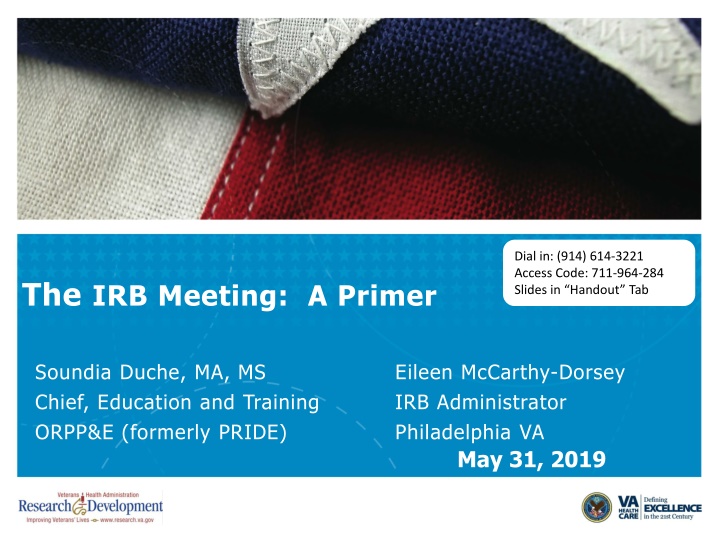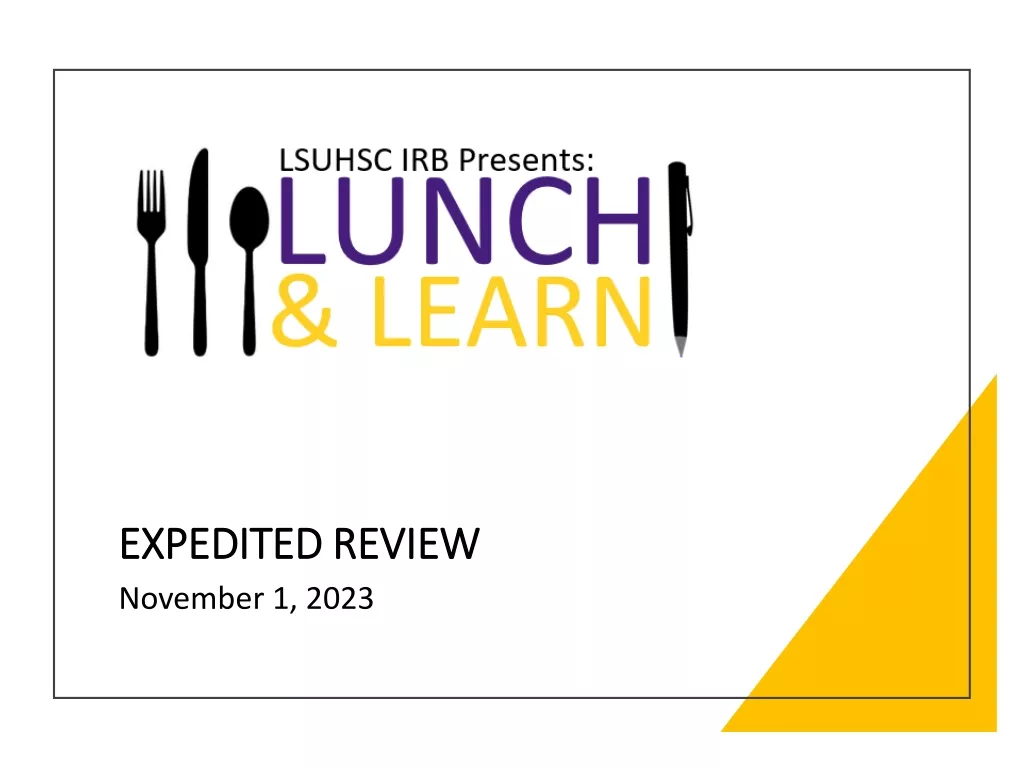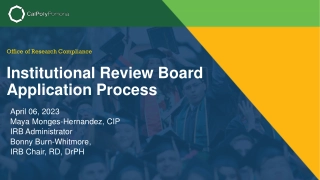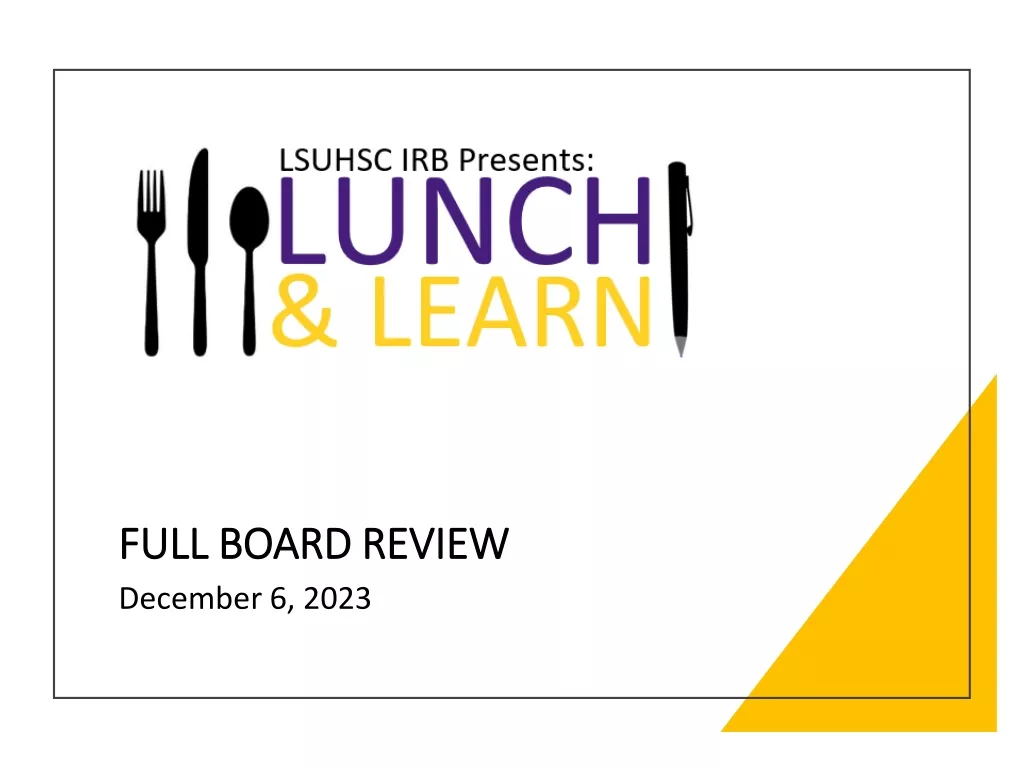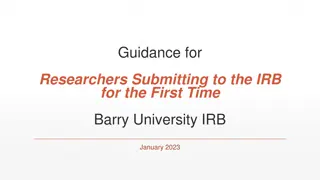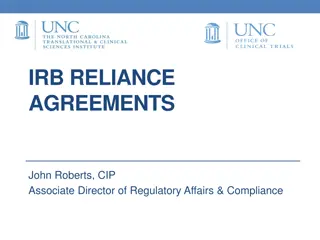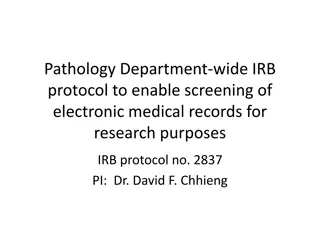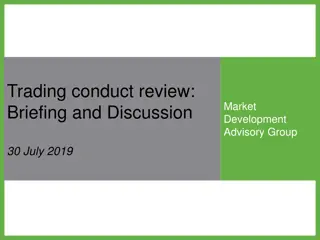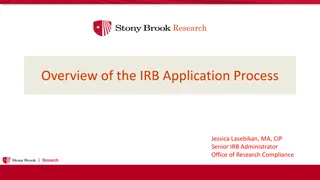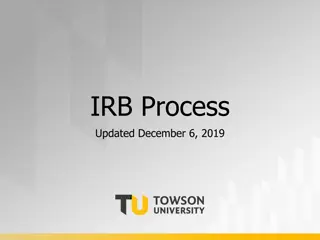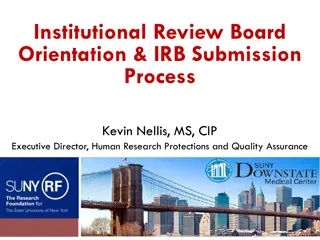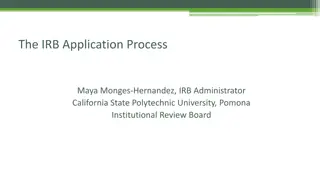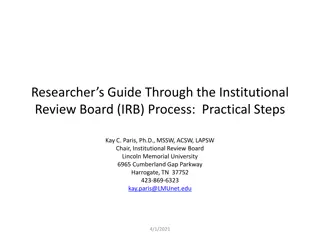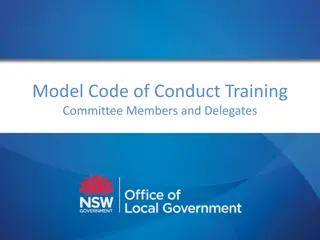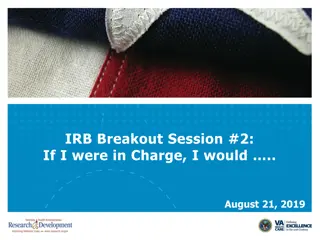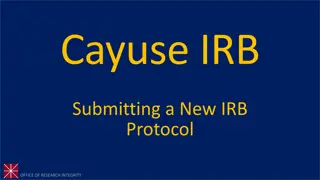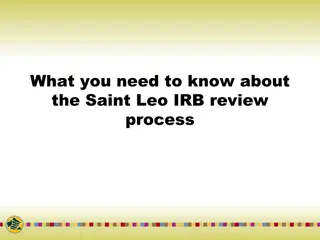Guide to IRB Meeting Preparation and Conduct
Learn about key regulatory requirements and best practices for convening and conducting an Institutional Review Board (IRB) meeting. This guide covers pre-meeting activities, achieving quorum, member attendance, conflicts of interest, and more.
Download Presentation

Please find below an Image/Link to download the presentation.
The content on the website is provided AS IS for your information and personal use only. It may not be sold, licensed, or shared on other websites without obtaining consent from the author.If you encounter any issues during the download, it is possible that the publisher has removed the file from their server.
You are allowed to download the files provided on this website for personal or commercial use, subject to the condition that they are used lawfully. All files are the property of their respective owners.
The content on the website is provided AS IS for your information and personal use only. It may not be sold, licensed, or shared on other websites without obtaining consent from the author.
E N D
Presentation Transcript
Dial in: (914) 614-3221 Access Code: 711-964-284 Slides in Handout Tab The IRB Meeting: A Primer Soundia Duche, MA, MS Chief, Education and Training ORPP&E (formerly PRIDE) Eileen McCarthy-Dorsey IRB Administrator Philadelphia VA May 31, 2019
Objectives Identify key regulatory requirements to convene and conduct an IRB meeting Describe best practices for preparing and conducting a convened IRB meeting Identify key regulatory requirements that must be included in IRB minutes 2
Dial in: (914) 614-3221 Access Code: 711-964-284 Slides in Handout Tab Overview Pre-Meeting Activities Meeting Activities Post-Meeting Activities Challenges Encountered Open Q&A Session 3
Anticipating Member Attendance and Ability to Achieve Quorum Confirm Who is Planning to Attend Members (voting and non-voting) Alternate members of voting members Non-Scientific voting member(s) Guests (consultants, observers, study teams) Identify Conflicts of Interest (COI) Conflicted members must recuse themselves (should leave the room) and cannot count towards quorum Ensure ability to achieve quorum 5
Quorum Quorum is the minimum number and type of IRB member that must be present at a convened IRB meeting. Quorum calculation: majority of voting IRB members on the IRB Roster, to include a non-scientist SOPs should specify how majority is defined (e.g. simple majority) No review (discussion and/or vote) of proposed research can take place if quorum is lost. A member who chooses to abstain from the vote is still counted towards quorum. A member who recuses him/herself due to a conflict of interest does not count towards quorum. 6 Reference: 38 CFR 16.108(b)
Quorum: Examples IRB Roster has ten (10) voting members Quorum (simple majority): At least six voting members, one of whom is a non-scientist IRB Roster has seven (7) voting members Quorum (simple majority): At least four voting members, one of whom is a non-scientist If only four voting members are present at the meeting and one or more has to recuse themselves due to a COI, quorum has been lost and no further review and voting actions can take place until quorum has been reestablished. 7
Poll 1: Case Study 1 The IRB has 11 voting members on its roster. What is the number of members required for quorum (simple majority)? 4, including the non-scientist 5, including the non-scientist 6, including the non-scientist 11, including the non-scientist 8
Poll 2: Case Study 1 The IRB total membership is 8 voting members prior to the convened meeting of May 31st. Quorum is 5 including the non-scientist voting member. During today s convened IRB meeting in which 5 voting members are present, a scientist member states he or she no longer wants to be on the IRB and is quitting immediately. The member leaves the convened meeting. HINT: Quorum is the minimum number and type of IRB member that must be present at a convened IRB meeting Has the number of members required for quorum changed for the remainder of the convened meeting? Yes No 9
Meeting Agenda: Considerations Determining when a study should be placed on the agenda Pre-specified cut-off date prior to the meeting After administrative review and/or primary reviewer s initial review After study team addresses reviewer s initial set of comments Determining the order of the Agenda Items related to ongoing studies should be prioritized Continuing reviews have to be reviewed prior to the study expiration date Reportable events need to be reviewed by the timeframe specified in VHA Handbook 1058.01 New studies usually take the longest to review Availability of Study Team if invited to the meeting (not required) 10
Expedited Listing: Requirements Each IRB that uses an expedited review procedure shall adopt a method for keeping all members advised of research proposals that have been approved under the procedure. Reference: 38 CFR 16.110(c) The IRB must have written procedures for informing all members, investigators, and the R&D Committee of the decision and the expedited review eligibility category for any expedited review actions. Reference: VHA Directive 1200.05 Paragraph 11d. 11
Expedited Listing: Common and Best Practices Many IRBs choose to distribute the expedited listing before or at the meeting (appending it to the Agenda), IRB members can raise questions about any expedited action. At a minimum, expedited listing should include the protocol number, title, PI name, expedited category, and date of the approval by the expedited reviewer(s). Including a short summary of the action may also be helpful but not required. Example: Approved minor change in informed consent document. 12
Meeting Tools Tools are often used to assist reviewers and aid in minutes preparations. Meetings tools are not required to be used by federal regulations or ORD polices. Agenda Tools Used to ensure that required determinations are made when reviewing new protocols and/or reportable events Voting Matrices Used to track votes for each item Reviewer Forms Used to document reviewer s comments as well as required determinations to support IRB s discussion and decisions at the meeting 13
Logistics and Tracking Using audio recording in addition to handwritten notes Note recordings cannot take the place of written meeting minutes Recording meeting start and end times Confirming and tracking recusals for COIs Documenting attendance of members to include which members are serving as alternates Tracking members to ensure quorum is maintained throughout the meeting Tracking recusals (particularly recusals by the non-scientist) Tracking members who arrive late and/or leave early 15
Miscellaneous Items During a Convened Meeting Announcements Review and vote on previous meeting minutes No regulatory requirement to approve/vote on meeting minutes. Local SOPs dictate processes Review of expedited listing Local SOPs dictate processes Keeping track of time if a study team is on standby to call in 16
Order of Items on the Agenda Continuing Reviews Amendments Reportable Events Unanticipated Problems Involving Risks to Subjects or Others Serious Adverse Events Serious or Continuing Noncompliance Suspensions and Terminations Re-review of Protocols Initially Reviewed by the Convened IRB requiring return to convened IRB New Protocols Other 17
New Protocols and Amendments: IRB Discussion and Determinations IRB Discussion of item to include Controverted issues and resolution Controverted issues are those that cause controversy, dispute/disagreement, and/or debate among members Risk Level Determinations Minimal risk, Greater than minimal risk study Significant/Non-Significant Risk Device Determinations .111 Approval Criteria 18
New Protocols and Amendments: IRB Discussion and Determinations (cont.) Informed consent requirements to include waivers Waivers of HIPAA Authorization FDA Requirements for FDA-Regulated Studies Required determinations for research involving vulnerable populations (examples - Children, Prisoners; Pregnant Women) Required modifications Approval period and frequency of continuing review when applicable Reasons for deferrals or disapprovals 19
IRB Actions Approve Approve with conditions (aka approve with minor mods) IRB must be able to stipulate what modifications are required (must be directive) IRB minutes or SOPs should specify who can review the response outside of the convened IRB. Require modifications in (to secure approval) IRB is unable to make all determinations required for approval Requested modifications must be reviewed by the convened board Suspend Disapprove Terminate 20 References: 38 CFR 16.109(a); 38 CFR 16.113
IRB Actions The IRB or institution may develop a range of other allowable actions the IRB may take when reviewing proposed research activities. The IRB s written procedures should describe the range of possible actions the IRB can take. Examples include, but are not limited to: Defer Table Other 21
Voting on IRB Actions Only voting members can vote on IRB actions (to include alternates that are substituting for a voting member). Members that are absent can send in comments and opinions that can be presented at the meeting however they cannot vote in absentia. Use of Voting matrix as a tool helps to keep track of actual votes. 22
Vote on IRB Actions (cont.) In order for the IRB to approve research, it must receive the approval of a majority of voting members present at the meeting. If 10 voting members are present at the time of the vote on the action, at least 6 of them must vote to approve the action for the action to be approved. Record the vote on actions including the number of voting members voting For Against Abstaining Track any recusals or members not present for the vote 23
Poll 3: Case Study 2 15 voting members are present during the review and vote of a new study to include 2 non-scientists (Quorum for this IRB is 11) No conflicts of interest have been declared A motion is made to approve the study What is the minimum number of members that must vote in favor of the motion for the study to be approved? 8 9 10 15 24
Poll 4: Case Study 2 The next item on the agenda is a reportable Serious Adverse Event (SAE) according to VHA Handbook 1058.01 for the same IRB that has 15 members present (including two non-scientists). Quorum is 11. One (1) non-scientist member receives an urgent call and has to leave the room during the discussion and does not return to the meeting. One (1) scientific member declares a COI and recuses herself from the entire meeting and also does not return. A motion is made that the reportable event is not serious, and/or the incident was not unanticipated, and/or the incident was not related to the research 25 Reference: VHA Handbook 1058.01, Paragraph 6.d.
Poll 4: Case Study 2 What is the minimum number of members that must vote in favor of the motion for it to be approved ? 7 8 9 13 Vote cannot take place 26
Meeting Minutes: Common Rule Minutes of IRB meetings must include the following: attendance at the meetings; actions taken by the IRB; the vote on these actions including the number of members voting for, against, and abstaining; the basis for requiring changes in or disapproving research; written summary of the discussion of controverted issues and their resolution. Reference: 38 CFR 16.115(a)(2) 28
Meeting Minutes: VHA Directive 1200.05 Requirements In addition to the requirements included in the Common Rule, VHA Directive 1200.05, Paragraph 8.c.(1) also states that the following determinations must be included in the IRB Minutes. IRB determination that all criteria for approval of the research are satisfied. Documentation that all criteria for a waiver or alteration of informed consent/documentation of informed consent have been met, when applicable. 29
Going Beyond the Regulatory and ORD Policy Requirements for IRB minutes Local VA policies may be more robust with respect to what must be included in meeting minutes If your SOPs state that you will include a determination in your minutes then you must include it in your minutes Additional IRB Required Determinations must still be documented Best Practices should be taken into consideration when determining what should be included in meeting minutes vs other sources like reviewer forms, checklists, approval notices, etc. Reviewer Forms can provide supporting documentation of specific determinations made by the IRB 30
Meeting Minutes Template VA CIRB Meeting Minutes Template 31
Circulation of IRB Minutes A copy of the final IRB minutes must be submitted to the R&D Committee in accordance with local SOPs. When the IRB of Record for a VA facility is the IRB of a non-VA entity, the non-VA entity must (a) Provide VA with, or access to unredacted copies of meeting minutes in a timely manner that allows the R&D Committee to review the IRB s deliberations on VA protocols; or Reference: VHA Directive 1200.05, Paragraph 8.c.(3) 32
Circulation of IRB Minutes (cont.) When the IRB of Record for a VA facility is the IRB of a non-VA entity, the non-VA entity must (b)Provide VA with, or access to, redacted copies of meeting minutes in a timely manner that allows the R&D Committee to review the IRB s deliberations on VA protocols. The non-VA entity must permit relevant VA personnel (including, but not limited to, ORO staff, local VA research office staff, local RCOs, and R&D Committee members) to review the unredacted meeting minutes within 2 business days of a written request from VA. Reference: VHA Directive 1200.05, Paragraph 8.c.(3) 33
IRB Letters and Notifications Create templates for various notification letters Notification letters are usually written prior to the meeting minutes Use information from notification letter in meeting minutes (e.g. summary, modifications required, and required statements) Write in 3rdperson so that you don t have to edit the content when placing it in meeting minutes Include list of items approved in notification letter 34
Challenges 35
Common Challenges and Struggles Lots of items require return to the convened IRB after an initial review Meeting minutes are too long Pages and pages of required modifications Takes a very long time to prepare meeting minutes and/or IRB letters 36
Questions 37
Contact Information Soundia Duche Chief, Education and Training Office of Research Protections, Policy, and Education Office of Research and Development Washington, DC Soundia.Duche@va.gov Eileen McCarthy-Dorsey IRB 1 Administrator Cpl. Michael J. Crescenz VAMC Research & Development Philadelphia, PA Eileen.McCarty-Dorsey@va.gov 38
Important Links Final Rule for the Delay (published June 19, 2018) Revised Common Rule (published January 19, 2017) Pages 7259 to 7274 contain the Text of the Final Rule Current Common Rule VHA Directive 1200.05 VHA Directive 1200.01 ORD Policies and Guidance Documents ORPP&E Cyberseminars 39
